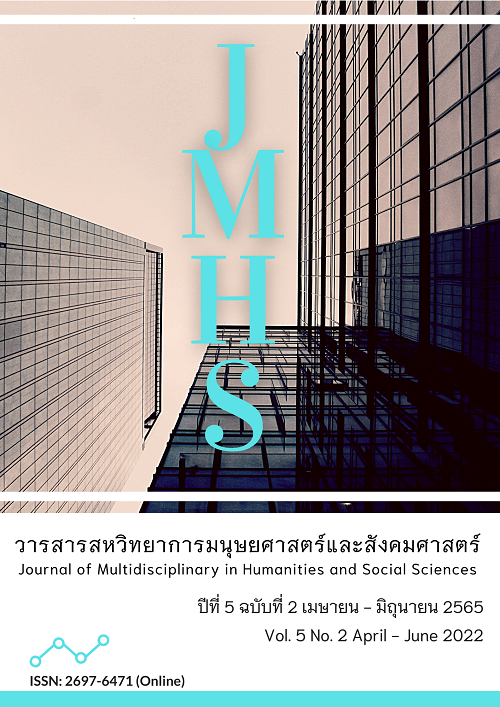The Study the of Vipassana Practice in Dukkha Sutta
Main Article Content
Abstract
This article aimed 1) to study the contents and Buddha’s teachings that appeared in the Dukkha Sutta and 2) to apply the contents and principalities in the Dukkha Sutta to the practical task of insight meditation. This was documentary research done by taking many compendiums in Theravada Buddhism, i.e., Tipitaka and its related commentaries such as Pakarana and Visuddhimagga, along with approved documents from academic lectures, then analysis, and finally written in descriptive type.
The results of the study revealed that Dukkha Sutta is a discourse in which the Buddha taught two groups of Dhamma to meditator Bhikkhus, each of which consists of six elements, namely, the Dhamma in the category of unwholesome, which consists of six: 1) sensual pleasure thought, 2) ill-will, 3) thought of violence, 4) sensual pleasure perception. 5) ill-will perception, and 6) violence perception, which cause suffering, fervor, and wrong destiny after death, i.e., hell entering, beast, and an animal world, and there are 6 virtues in the category of wholesomeness, namely, 1) thought of renunciation, 2) thought of free from hatred, 3) thought of non-violence, 4) renunciation perception, 5) perception free from ill-will, and 6) perception free from violence.
In the practice of Vipassana meditation found in Dukkha Sutta, it was found that this discourse was a direct practice of Vipassana meditation in the category of Dhammānupassanā by observing sensual pleasure, thoughts., etc. which is unwholesome. When the meditator realizes such objects, his mind will reach to renunciation of thoughts which is wholesome. Having completely understood these six virtues in both sides, he will soon comprehend his insight and knowing the common manners of all phenomena falling into ever-changing, contradictory and non-self.
Article Details

This work is licensed under a Creative Commons Attribution-NonCommercial-NoDerivatives 4.0 International License.
Views and opinions appearing in the Journal it is the responsibility of the author of the article, and does not constitute the view and responsibility of the editorial team.
References
นงลักษณ์ สะวานนท์. (2559). บุญกริยาวัตถุสู่การพ้นทุกข์. กรุงเทพฯ: ขุมทองอุตสาหกรรมและการพิมพ์.
พระครูสุตจินดาภรณ์ (ยงยุทธ าณสมฺปนฺโน). (2560). การศึกษาแนวทางการประยุกต์ใช้หลักไตรลักษณ์เพื่อบรรเทาทุกข์ ของคนในสังคมปัจจุบัน(วิทยานิพนธ์พุทธศาสตรมหาบัณฑิต).มหาวิทยาลัยมหาจุฬาลงกรณราชวิทยาลัย.
พระเจนฑ์จันทร์ จนฺทปญฺโ (2560). ศึกษาวิเคราะห์วิธีการดับทุกข์ตามแนวทางพระพุทธศาสนาเถรวาท(วิทยานิพนธ์พุทธศาสตรมหาบัณฑิต). มหาวิทยาลัยมหาจุฬาลงกรณราชวิทยาลัย.
พระเทิดพงษ์ สุทฺธิญาโณ (2561). ศึกษามูลเหตุแห่งการบรรลุธรรมที่ปรากฏในวิมุตตายตนสูตร(วิทยานิพนธ์พุทธศาสตรมหาบัณฑิต). มหาวิทยาลัยมหาจุฬาลงกรณราชวิทยาลัย.
พระธรรมกิตติวงศ์ (ทองดี สุรเตโช). (2550). พจนานุกรมเพื่อการศึกษาพุทธศาสตร์ ชุดคำวัด.กรุงเทพฯ: เลี่ยงเชียง.
พระพรหมคุณาภรณ์ (ป.อ.ปยุตฺโต). (2556). พจนานุกรมพุทธศาสน์ ฉบับประมวลศัพท์. (พิมพ์ครั้งที่ 19). กรุงเทพฯ: โรงพิมพ์พระพุทธศาสนาของธรรมสภา.
พระพรหมคุณาภรณ์ (ป.อ.ปยุตฺโต). (2557). พุทธธรรม ฉบับปรับขยาย. (พิมพ์ครั้งที่ 39). กรุงเทพฯ: มหาจุฬาลงกรณราชวิทยาลัย.
พระพรหมมังคลาจารย์ (ปัญญานันทภิกขุ). (2539). เคล็ดลับของความดับทุกข์. กรุงเทพฯ: เลี่ยงเชียง.
พระพุทธโฆสเถระ. (2554). คัมภีร์วิสุทธิมรรค. (สมเด็จพระพุฒาจารย์ (อาจ อาสภมหาเถร), ผู้แปล). (พิมพ์ครั้งที่ 10). กรุงเทพฯ: ธนาเพรส .
พระโสภณะเถระ (มหาสีสยาดอ). (2554.). วิปัสสนานัย เล่มที่ 2. กรุงเทพฯ: ไพลินบู๊คส์,
มหาจุฬาลงกรณราชวิทยาลัย. (2539). พระไตรปิฎกภาษาไทย ฉบับมหาจุฬาลงกรณราชวิทยาลัย.กรุงเทพฯ: โรงพิมพ์มหาจุฬาลงกรณราชวิทยาลัย.
สังข์วาล เสริมแก้ว, ธานี สุวรรณประทีป, ชลิต วงษ์สกุล และ พระครูปลัดประวิทย์ วรธมฺโม. (2565). การบูรณาการหลักอัตถะ 3 ในการสังคมสงเคราะห์ : บทวิเคราะห์ในมิติพระพุทธศาสนา. วารสาร มจร บาฬีศึกษาพุทธโฆสปริทรรศน์8(1),1-15


